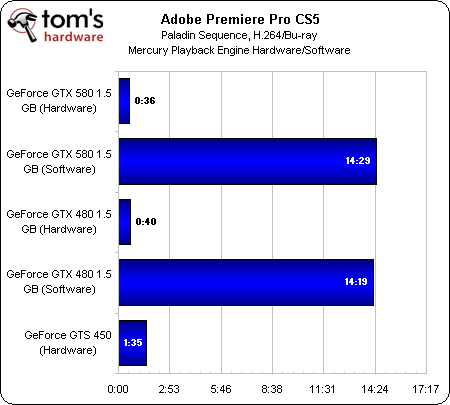GeForce GTX 580 And GF110: The Way Nvidia Meant It To Be Played
After an arguably disappointing GeForce GTX 480 launch back in March, we knew the company had to be working hard on a successor. Meet its flagship GeForce GTX 580, based on the GF110 GPU. This time around, Nvidia proves the idiom "better late than never."
Benchmark Results: Adobe Premiere Pro CS5
We’ve been looking for non-gaming-oriented applications to fold into our graphics card reviews for a while, and Adobe’s software is widely-enough used by professionals and power users alike to demonstrate the merits of GPU-based computing. We’ve held back on less-popular tests in the past, but enough of us use Adobe’s software, which now supports this technology natively, that it makes more sense to start adding it.
Bear in mind that the Mercury Playback Engine only supports a limited number of CUDA-capable graphics cards. Of course, neither the GeForce GTX 480 or 580 are included in that list (humorously, the GeForce GTX 470 is), so Premiere gets “hacked” to make those cards work (see William Van Winkle’s exploration of performance in CS5 for instructions on how to do that). I’m leaving AMD’s cards out because this isn’t an AMD versus Nvidia battle. It’s all about hardware (GPU) against software (CPU) rendering—expect the AMD cards to look a lot like the Nvidia cards running in software mode. That score is most dependent on our Core i7-980X overclocked to 4.2 GHz.
The hardware-accelerated configurations are more than 20 times faster than rendering in software. No surprise there. The question is: should you spend the extra money on a $500 graphics card to help improve your experience with Adobe’s Mercury Playback Engine? Probably not. Even our baseline GeForce GTS 450 finished this effects-laden project in 1:35. And while the GTX 580 shaves off four seconds from the 480’s time, such high-end hardware is only really worth it if gaming is your first priority. Otherwise, a more mainstream (supported) GPU would be plenty.
Get Tom's Hardware's best news and in-depth reviews, straight to your inbox.
Current page: Benchmark Results: Adobe Premiere Pro CS5
Prev Page Benchmark Results: Just Cause 2 (DX11) Next Page Benchmark Results: SLI-
KT_WASP The last bit of the article is the most important I think. Anyone who drops $500 on this card right now, before Cayman releases, should have their head examined. With two companies releasing so close together, it would be in a person's best interest to see what the other is bringing to the table before shelling out such a large chunk of change.Reply
If the 6850 and 6870 have shown one thing.. they are much better then the last gen in many ways (power, noise and scaling) and the cayman is much more robust then the barts. So, before you start calling a winner here, wait and see. That is my advise. -
awood28211 Sound performance but the game here seems to be...double leap-frog. You can just release a product that competes with the competitors current offerings, you gotta compete with what he releases next... If AMD's next offering is significantly faster than it's current, then NVIDIA will still be playing catchup.Reply -
Wheat_Thins Kinda pointless article other then the fact that the 580 offers superb performance but until I see power and noise set in stone I honestly don't care.Reply
A single GPU nearly outperforming a 5970 is quite a statement. Wonder if AMD has what it takes to answer this as the 6850 IMPO is pretty disappointing other then the price. -
nevertell So it's basically what the 480 should have been. Fair enough, I'll wait for the 470 version of the gf110 and buy that.Reply -
TheRockMonsi The price right now for this card is way over $500 on newegg. For that price NVIDIA better be giving me a bj as well.Reply -
It'll certainly be interesting, even if i don't agree with NVIDIA playing catchup. The 480 had its flaws, but it still was the fastest single GPU around.Reply
We'll see what the 69xx have to offer. NVIDIA releasing now puts somewhat of a time constraint on AMD though. If it takes them too long to get something out the door, even some people waiting now may just get the 580 for christmas. -
kevin1212 Nvidia is embarrassed by the power draw of the gtx 580, haha. Improvement in performance but uses the same amt of power... still not a big enough improvement in efficiency, and no big leap in value either. AMD will wipe the floor with this card.Reply
By the way, i know you guys decided to drop crysis, and i can understand that, but given that this is a high end card, maybe you should have considered it, since frankly anyone buying a card like this would probably want it for crysis more than anything else. A 6870 is more than enough for the others. -
iamtheking123 Looks to me that the 580 is somewhere between a 5870 and a 5970. Might have been more impressive if it was Q2 2010 and not Q4 2010.Reply
With ATI's meat-and-gravy bits of the 6000 series on the launchpad, you'd be an idiot to buy one of these at this price.

